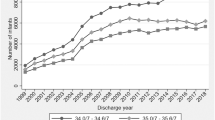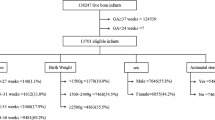Abstract
Objective:
Group prenatal care (GC) models are receiving increasing attention as a means of preventing preterm birth; yet, there are limited data on whether group care improves perinatal outcomes in women who deliver at term. The purpose of this study was to evaluate our institutional experience with GC over the past decade and test the hypothesis that GC, compared with traditional individual care (TC), improves perinatal outcomes in women who deliver at term.
Study Design:
We performed a retrospective cohort study of women delivering at term who participated in GC compared with TC. A group of 207 GC patients who delivered at term from 2004 to 2014 were matched in a 1:2 ratio to 414 patients with term singleton pregnancies who delivered at our institution during the same period by delivery year, maternal age, race and insurance status. The primary outcome was low birth weight (<2500 g). Secondary outcomes included early term birth (37.0 to 38 6/7 weeks), 5 min APGAR score <7, special care nursery admission, neonatal intensive care unit (NICU) admission, neonatal demise, cesarean section and number of prenatal visits. Outcomes were compared between the two groups using univariable statistics.
Results:
Baseline characteristics were similar between the two matched groups. GC was associated with a significant reduction in low birth weight infants compared with TC (11.1% vs 19.6%; relative risk (RR) 0.57; 95% confidence interval (CI) 0.37 to 0.87). Patients in GC were significantly less likely than controls to require cesarean delivery, have low 5 min APGAR scores and need higher-level neonatal care (NICU: 1.5% vs 6.5%; RR 0.22; 95% CI 0.07 to 0.72). There were no significant differences in rates of early term birth and neonatal demise.
Conclusions:
Low-risk women participating in GC and delivering at term had a lower risk of low birth weight and other adverse perinatal outcomes compared with women in TC. This suggests GC is a promising alternative to individual prenatal care to improve perinatal outcomes in addition to preterm birth.
This is a preview of subscription content, access via your institution
Access options
Subscribe to this journal
Receive 12 print issues and online access
$259.00 per year
only $21.58 per issue
Buy this article
- Purchase on SpringerLink
- Instant access to full article PDF
Prices may be subject to local taxes which are calculated during checkout
Similar content being viewed by others
References
Krans EE, Davis MM . Strong Start for Mothers and Newborns: implications for prenatal care delivery. Curr Opin Obstet Gynecol 2014; 26 (6): 511–515.
Rising SS . Centering pregnancy: an interdisciplinary model of empowerment. J Nurse Midwifery 1998; 43 (1): 46–54.
Ickovics JR, Kershaw TS, Westdahl C, Magriples U, Massey Z, Reynolds H et al. Group prenatal care and perinatal outcomes: a randomized controlled trial. Obstet Gynecol 2007; 110 (2 I): 330–339.
Picklesimer AH, Billings D, Hale N, Blackhurst D, Covington-Kolb S . The effect of CenteringPregnancy group prenatal care on preterm birth in a low-income population. Am J Obstet Gynecol 2012; 206 (5): 415e1–415e7.
Tanner-Smith EE, Steinka-Fry KT, Lipsey MW . The effects of CenteringPregnancy group prenatal care on gestational age, birth weight, and fetal demise. Matern Child Health J 2014; 18 (4): 801–809.
Klima C, Norr K, Vonderheid S, Handler A . Introduction of CenteringPregnancy in a public health clinic. J Midwifery Women's Health 2009; 54 (1): 27–34.
Shakespear K, Waite PJ, Gast J . A comparison of health behaviors of women in centering pregnancy and traditional prenatal care. Maternal Child Health J 2010; 14 (2): 202–208.
Robertson B, Aycock DM, Darnell LA . Comparison of centering pregnancy to traditional care in Hispanic mothers. Maternal Child Health J 2009; 13 (3): 407–414.
Carter EB, Temming LA, Akin J, Fowler S, Macones GA, Colditz GA et al. Group prenatal care compared with traditional prenatal care: a systematic review and meta-analysis. Obstet Gynecol 2016; 128 (3): 551–561.
Pearce N . Analysis of matched case-control studies. BMJ 2016; 352: i969.
Ford K, Weglicki L, Kershaw T, Schram C, Hoyer PJ, Jacobson ML . Effects of a prenatal care intervention for adolescent mothers on birth weight, repeat pregnancy, and educational outcomes at one year postpartum. J Perinat Educ 2002; 11 (1): 35–38.
Ickovics JRK, Kershaw TS, Westdahl C, Rising SS, Klima C, Reynolds H et al. Group prenatal care and preterm birth weight: results from a matched cohort study at public clinics. Obstet Gynecol 2003; 102 (5 Pt 1): 1051–1057.
Kennedy HP, Farrell T, Paden R, Hill MS, Rima Jolivet R, Cooper BA et al. A randomized clinical trial of group prenatal care in two military settings. Mil Med 2011; 176 (10): 1169–1177.
Jafari F, Eftekhar H, Fotouhi A, Mohammad K, Hantoushzadeh S . Comparison of maternal and neonatal outcomes of group versus individual prenatal care: a new experience in Iran. Health Care Women Int 2010; 31 (7): 571–584.
Alexander GR, Himes JH, Kaufman RB, Mor J, Kogan M . A United States National reference for fetal growth. Obstet Gynecol 1996; 87 (2 I): 163–168.
Rondó PHC, Ferreira RF, Nogueira F, Ribeiro MCN, Lobert H, Artes R . Maternal psychological stress and distress as predictors of low birth weight, prematurity and intrauterine growth retardation. Eur J Clin Nutr 2003; 57 (2): 266–272.
Orr ST, James SA, Miller CA, Barakat B, Daikoku N, Pupkin M et al. Psychosocial stressors and low birthweight in an urban population. Am J Prev Med 1996; 12 (6): 459–466.
Borders AEB, Grobman WA, Amsden LB, Holl JL . Chronic stress and low birth weight neonates in a low-income population of women. Obstet Gynecol 2007; 109 (2 part 1): 331–338.
Heberlein EC, Picklesimer AH, Billings DL, Covington-Kolb S, Farber N, Frongillo EA . The comparative effects of group prenatal care on psychosocial outcomes. Arch Womens Ment Health 2015; 9 (2): 259–269.
Rosen MG, Merkatz IR, Hill JG . Caring for our future: a report by the expert panel on the content of prenatal care. Obstet Gynecol 1991; 77 (5): 782–787.
Villar J, Bergsjo P . Scientific basis for the content of routine antenatal care. I. Philosophy, recent studies, and power to eliminate or alleviate adverse maternal outcomes. Acta Obstet Gynecol Scand 1997; 76 (1): 1–14.
American Academy of Pediatrics; American College of Obstetricians and Gynecologists Guidelines for Perinatal Care. American Academy of Pediatrics; American College of Obstetricians and Gynecologists: Elk Grove Village, IL; Washington, DC, 2012. Available from http://search.ebscohost.com/login.aspx?direct=true&scope=site&db=nlebk&db=nlabk&AN=567165.
Acknowledgements
Dr Carter is supported by a NIH T32 training Grant (5T32HD055172-05).
Author information
Authors and Affiliations
Corresponding author
Ethics declarations
Competing interests
The authors declare no conflict of interest.
Rights and permissions
About this article
Cite this article
Carter, E., Barbier, K., Sarabia, R. et al. Group versus traditional prenatal care in low-risk women delivering at term: a retrospective cohort study. J Perinatol 37, 769–771 (2017). https://doi.org/10.1038/jp.2017.33
Received:
Accepted:
Published:
Issue Date:
DOI: https://doi.org/10.1038/jp.2017.33
This article is cited by
-
Exploring the feasibility of conducting a randomised controlled trial of group-based pregnancy care and education: a pilot randomised controlled trial in Melbourne, Australia
Pilot and Feasibility Studies (2024)
-
Group antenatal care: findings from a pilot randomised controlled trial of REACH Pregnancy Circles
Pilot and Feasibility Studies (2023)
-
Group antenatal care (Pregnancy Circles) for diverse and disadvantaged women: study protocol for a randomised controlled trial with integral process and economic evaluations
BMC Health Services Research (2020)



